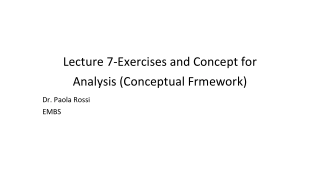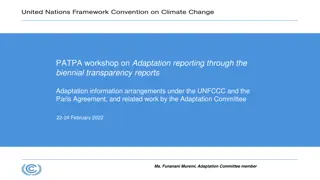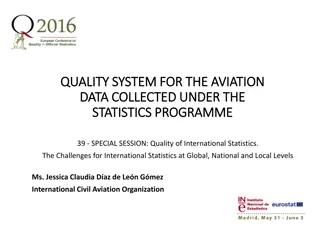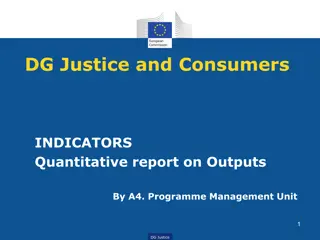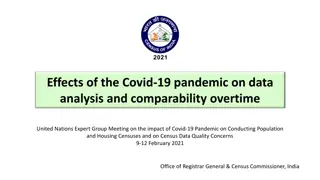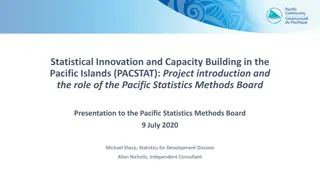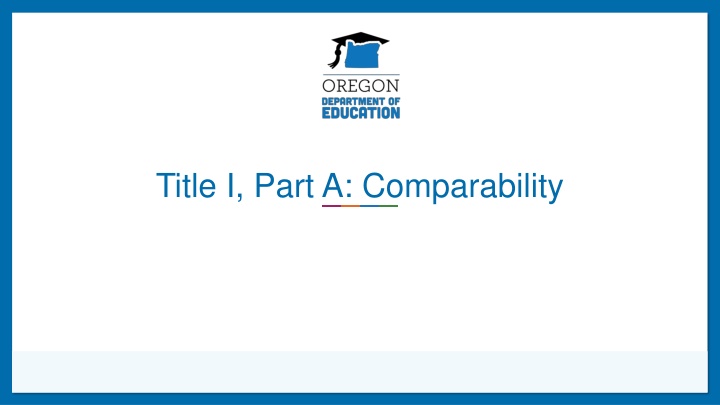
Title I Part A Comparability Requirements
Explore the basics of comparability in Title I Part A funding, including principles, exceptions, and obligations. Learn how districts demonstrate the supplemental use of funds, ensuring equitable distribution among schools regardless of Title I-A status.
Download Presentation

Please find below an Image/Link to download the presentation.
The content on the website is provided AS IS for your information and personal use only. It may not be sold, licensed, or shared on other websites without obtaining consent from the author. If you encounter any issues during the download, it is possible that the publisher has removed the file from their server.
You are allowed to download the files provided on this website for personal or commercial use, subject to the condition that they are used lawfully. All files are the property of their respective owners.
The content on the website is provided AS IS for your information and personal use only. It may not be sold, licensed, or shared on other websites without obtaining consent from the author.
E N D
Presentation Transcript
Outcomes Comparability Basics Demonstrating Comparability Exceptions & Exemptions Resources Oregon Department of Education
Supplement Not Supplant Federal funds cannot be used to supplant, or take the place of, funds that would have been spent if Title I-A funds were not available Comparability is one of three fiscal tests for Title I-A through which districts demonstrate that their use of Title I-A funds is supplemental Supplement not Supplant Title IA Fiscal Requirements Maintenance of Effort ESSA Quick Reference Brief: Comparability Comparability Oregon Department of Education
Comparability Basics What: A comparison of the use of funds in Title I-A and non- Title I-A funded schools Why: To determine whether the distribution of State and local funds and resources to schools are comparable regardless of Title I-A status When: October 1: CIP Budget Narrative Assurances December 1: Comparability Report Oregon Department of Education
Assurances District superintendents sign and submit these assurances by June 30 each year for the subsequent year. In the assurances the district attests that it has implemented: 1. an LEA wide salary schedule; 2. a policy to ensure equivalence among schools in teachers, administrators, and other staff; and 3. a policy to ensure equivalence among schools in the provision of curriculum materials and instructional supplies.
Student-Instructional Staff Ratio Methods for Demonstrating Comparability Student-Instructional Staff Salary Ratio Per Pupil Expenditures Resource Allocation Plan based on student characteristics Oregon Department of Education 6
Student-Instructional Staff Ratio Comparison of the average number of students per instructional staff in I-A funded and non I-A funded schools Count student enrollment and staff assignments on the same day Do not include staff whose full salaries are paid with federal dollars Instructional staff are defined as anyone who provides direct instruction to children or who assists or supervises those staff members who provide instruction. Oregon Department of Education 7
Alternate Methods Student-instructional staff salary ratio Comparison of average salary expenditure per student Uses the base salary for each type of FTE, not actual cost Per Pupil Expenditure Comparison of allocation of funds for the purchase of instructional staff and materials Resource Allocation Plan Allocations to schools based on student characteristics (i.e.; weighted student formula) Oregon Department of Education 8
Comparability At-a-Glance Exceptions All public school districts that accept Title I-A funds. All schools in the district, including charter schools. Which students? All K-12 students in the district, whether enrolled in a Title I-A or non-Title I-A school. Which staff? All certified and non-certified instructional staff who are paid with State and local funds. Districts with one building per grade span. A school with fewer than 100 students enrolled. Which districts? Which schools? Non-instructional educational assistants; staff whose full salaryis paid with federal dollars. Oregon Department of Education 9
Exemptions & Exclusions LEAs are exempt from demonstrating comparability when there is one school per grade span Schools with fewer than 100 students may be excluded from the calculation State/local funds that can be excluded from calculation Language instruction for emergent bilingual students Excess costs of providing services to students experiencing disability Staff salary differentials for years of employment Supplemental programs that meet the intent and purpose of Title I Oregon Department of Education 10
Lets look at some scenarios! District #1: One elementary school, grades K-5 (Title I schoolwide) One middle school, grades 6-8 (Title I targeted assistance) One high school, grades 9-12 (non-Title I) This district is NOT required to complete the Comparability Report because there is only one school per grade span. Oregon Department of Education 11
Lets look at some scenarios! District #2: Three elementary schools, grades K-5 (all Title I schoolwide) One middle school, grades 6-8 (Title I targeted assistance) One high school, grades 9-12 (Title I-A targeted assistance) This district is required to complete the Comparability Report to demonstrate comparability among the elementary schools only. The district is not required to complete the Comparability Report for the middle and high school because there are no other schools in those grade spans to which they can be compared. Oregon Department of Education 12
Lets look at some scenarios! District #3: Two elementary schools, grades PK 2 and 3 5 One middle school, grades 6 8 One high school, grades 9 12 The two elementary schools receive Title I funds. This district is NOT required to complete the Comparability Report because the grade spans in the elementary schools do not overlap. Oregon Department of Education 13
Lets look at some scenarios! District #4: One elementary school, grades PK 5 (Title I schoolwide) One middle school, grades 6 8 (Title I schoolwide) One high school, grades 9 12 (Title I targeted assistance) One alternative high school, grades 9 12 (non-Title I) This district is required to complete the Comparability Report only if the alternative high school has an enrollment greater than 100 students. Oregon Department of Education 14
Comparability Report In order to meet the annual target date of December 1, an LEA should collect the comparability report information by October 1of each school year The information on the Comparability Report needs to match the information on the Title I-A Budget Narrative regarding schools being funded Once completed, the district s Comparability Report is accompanied by a Signature Page, signed by the district s Superintendent Relevant documents can be found on the Title I-A Data Collection webpage Oregon Department of Education 15
ESSA Quick Reference Brief: Comparability Resources Sample Comparability Timeline Supplement not Supplant under Title I, Part A Oregon Federal Funds Guide Comparability Report FAQs Title I-A Data Collections Oregon Department of Education 16
Please reach out! Jen Engberg Jennifer.Engberg@ode.oregon.gov Sarah Martin Sarah.Martin@ode.oregon.gov Lisa Plumb Lisa.Plumb@ode.oregon.gov Amy Tidwell Amy.Tidwell@ode.oregon.gov Kyle Walker Kyle.Walker@ode.oregon.gov Oregon Department of Education 17
Jen Engberg Clackamas, Columbia Gorge, Multnomah and Northwest Regional Sarah Martin Douglas, Lake, Malheur, South Coast and Southern Oregon Lisa Plumb Lane, Linn Benton Lincoln and Willamette Regional Contacts by ESD Amy Tidwell o Grant, Harney, High Desert, InterMountain, Jefferson, North Central and Region 18 Oregon Department of Education 18

